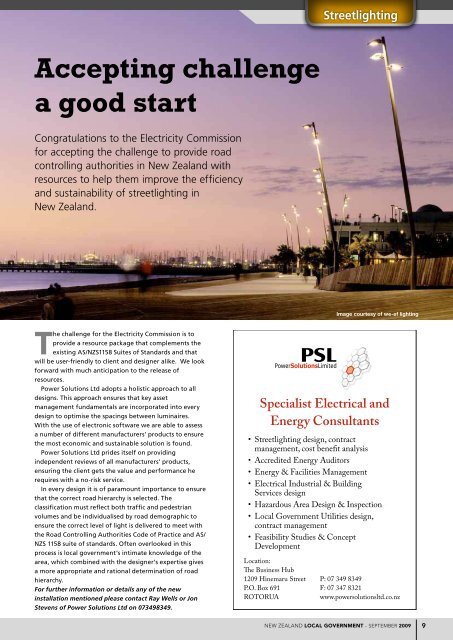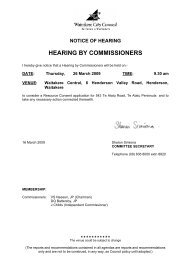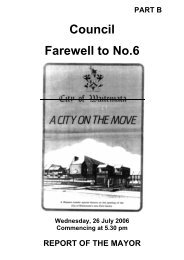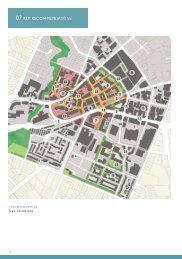'Street Lighting Update' produced by Local ... - Auckland Council
'Street Lighting Update' produced by Local ... - Auckland Council
'Street Lighting Update' produced by Local ... - Auckland Council
You also want an ePaper? Increase the reach of your titles
YUMPU automatically turns print PDFs into web optimized ePapers that Google loves.
StreetlightingStreet lighting is no longerbusiness as usualBy Michelle Dawsoncorporate sustainability manager, WaitakereCity <strong>Council</strong><strong>Council</strong>s and consultantsthroughout New Zealand aretrialling the new range of energyefficient street lighting technologies toassess their impacts on design andmaintenance processes.With the substantial improvements inenergy efficiency, councils are having toadapt in terms of their planning andbudgeting for street lighting; it is nolonger business as usual.Questions being asked <strong>by</strong> industryplayers include: what are the lumendepreciation rates of these newtechnologies, what are the maintenanceissues, the frequency and purchase costs,and what are their other advantages anddisadvantages?The Waitakere City <strong>Council</strong> installed203 CosmoPolis new metal halide, 60-watt and 140-watt luminaires and 19Stealth light emitting diode (LED) 30-wattluminaires over 14 streets during streetlighting capital upgrade projects,including technology specific design forpole spacing.Energy savings are anticipated to rangefrom 23–55 per cent depending on thetechnology installed.Waitakere is reviewing the lightingoutcomes for comparable technologiesfor high-pressure sodium (HPS),Cosmopolis’ new metal halide and StealthLED to understand the technicaldifferences between the technologies.The New Zealand Housing Foundationdevelopment in Glen Eden, Waitakerechose to install two 30-watt solar LED andfour 60-watt LED lights in their privateroad development. With the support ofEcofriendly Light and Power Ltd, theprivate road now has LED lighting thatmeets the New Zealand lighting standardrequirements for a public road for futureproofing.North Shore City <strong>Council</strong> trialledreplacing its current HPS lamps with LEDlamps on existing poles for two selectedstreets to establish power consumption,lighting levels and residents’ satisfaction.The feedback given is that residentsprefer the look of the LED street lamps,which give a whiter light than thehigh-pressure sodium lamps.They also liked being energy efficientand more sustainable.However some residents voicedconcerns regarding the level of lighting,particularly the lack of light reachingtheir properties, as well as suddencut-offs in lighting levels with the LEDlights used.The lux (light) measurementsconfirmed there were variations inillumination levels provided <strong>by</strong> the LEDlights compared to the pre-existing HPSlanterns.This is because LED lights used in thetrial are more focussed than the HPS.The power consumption of the LEDlamps was lower on average, however thelevels of service being provided are notthe same in all cases.It became evident that replacingexisting lights with LED lights withoutrelocating light poles will not necessarilyimprove lighting levels. Further, there-design of pole spacing is necessary ifimprovements in levels of service are tobe achieved.The trial showed LED street lighting is apromising future technology forachieving lighting efficiency and powersavings.Hamilton City <strong>Council</strong> installed 12 RuudLEDway LED 40-watt streetlights in twostreets to assess their performancecompared with the existing 80-wattmercury vapour (MV) fittings on 7.3metre high poles with 34-46 metrespacings along the 16-metre wide roadreserves.A survey was undertaken prior to theremoval of these fittings that showed theilluminance levels fell well short ofcompliance with Australia New ZealandStandard <strong>Lighting</strong> for Roads and PublicPlaces (ANZSLRPP) P3 (Pedestrian)category.The brief for the new installation wasto meet or exceed this.The 40-watt Ruud LEDway LED streetlight fittings replaced the existing80-watt mercury vapour fittings on aone-for-one basis using existing lightpoles.The light output from the newinstallation was surveyed and proven tocomfortably exceed the requirements ofthe ‘old’ P3 category.Amendment 1 to ANZSLRPP 3.1 (Nov08) has now reduced the illuminancelevels for P3 category for installationsthat use white light.Compliance with this now reduced P3category can be achieved with 30-wattRuud LEDway LED fittings.Overall power usage was reduced <strong>by</strong> 44per cent while at the same time theaverage illuminance has increased <strong>by</strong> 86per cent and the minimum illuminanceincreased <strong>by</strong> 400 per cent.Light is at a minimum at the midpointbetween poles – being the furthestdistance from the light – and therelationship between average andminimum is important for safety reasons.Hamilton will also be the first city totrial a smart street lighting control andmonitoring system in New Zealand.Hamilton-based TranzGrid Solutionsformed an alliance with two Europeancompanies that have developed the smarttechnology for street lighting systems.TranzGrid Solutions is seeking toestablish a pilot project where 150 lightsin Hamilton will be retrofitted with thelatest street lighting technology.The system involves fitting a controllerand smart ballast to the existing light.From there a gateway unit willcommunicate with the lights, passingdata between the light and a centralmanagement system.The company is applying for a businessgrant through the Energy Efficiency andConservation Authority to move thisstrategy forward and the pilot project isanticipated to start in 2010.The major benefits to councils arereduced electricity consumption andmaintenance costs, measurable electricityusage for each lamp and accurate faultfinding and reporting.The system will also be the first to be10New ZEALAND LOCAL GOVERNMENT - SEPTEMBER 2009
Streetlightingaudited against the ElectricityCommission rule on reconciliation ofun-metered loads. The return oninvestment is believed to be four to sixyears.Transit’s Sate Highway 16/18 ‘WesternFlyer’ project includes the Illumination ofthe 14km of motorway due to complete<strong>Auckland</strong>’s Western ring-route in 2012.Aurecon’s specialist lighting group[previously Connell Wagner] wasengaged to undertake the lightingdesign.The project enabled Aurecon tocompare the tender design as atraditional solution, to a more innovativecontemporary one, while maintainingcompliance with the current AustraliaNew Zealand Standard <strong>Lighting</strong> for Roadsand Public Places.Traditional thinking used 250-wattHPS, 16,000-hour lamps in large, ingressprotection (IP) 44 luminaires (forprotection from dust, dirt or water) withlow-tech reflectors, on 15-metre poles asthe benchmark for four lane motorways;30 per cent waste-light and low lightoutput ratios were typical.Contemporary thinking uses 150-watt,40,000-hour, twin-arc lamps in full cut-offluminaires, with sealed IP66, highperformanceoptics on 12-metre poles.Lamp surfaces are not visible to traffic oraerial views and a 40 per cent reductionin electrical load per pole has beenrealised.Reductions in electrical supplyinfrastructure, skyglow, maintenance,windage and visual pollution are justsome of the benefits adding to what isessentially a cost neutral basis.Careful attention to the design detail,innovation and the implementation ofcontemporary international road lightingtechnology has created an efficient,durable piece of New Zealandinfrastructure.A trial was undertaken <strong>by</strong> OdysseyEnergy Ltd for South Waikato District inTokoroa to test some of the latesttechnologies in lighting from Gough,Kaos and CosmoPolis.While they are more expensive to buythe lights’ high-quality manufacturingand well-designed optics mean they arefar cheaper to operate than traditionallights.Both lights are calculated to have a25-year operational lifespan.The existing 12 150 watt HPS lightswere around 10 years old.In order to establish a useful baselinenew Gough G600 150 HPS were installedduring the testing period on existingpoles and spacing.Once the measurements were takenfour sets of three luminaires wereinstalled on the existing poles andspacing.This was to achieve a different lightinglevel for each carriageway of BridgeStreet.The higher lighting level was tested onthe southern side of the road with threeiridium 140-watt CosmoPolis and threeKaos lights with 150-watt metal halideand was a test for lighting in centralbusiness district areas only.The lower lighting level was tested onthe northern side with three iridiumImage courtesy of we-ef lighting90-watt CosmoPolis and three Kaos100-watt HPS and was a test for lightingin V (Vehicle) category non-centralbusiness district areas (e.g. Bridge Streetaway from the central business districtarea, Balmoral Drive etc).The lights on the southern carriagewayrevealed it was possible to have greatlyimproved lighting (approximately 40 percent higher) with an attendant energysaving (approximately 10 per cent) andslightly reduced overall costs (6 per cent).The lights on the northern carriagewayrevealed that it was possible to have thesame overall lighting level (8 per centmore) with an attendant energy saving(approximately 40 per cent) and reducedoverall costs (28 per cent).The trial lights have a higher IP rating(ingress protection rating) Page 14New ZEALAND LOCAL GOVERNMENT - SEPTEMBER 2009 11
StreetlightingLED future bright – present less clearAtrial carried out <strong>by</strong> North ShoreCity <strong>Council</strong> found that whileLEDs have a bright future asstreetlights, they are not quite there yet.Mike Russell, senior asset engineer inthe council’s transport department, saidthe trial in underlit streets in Brown’s Bayand Sunnynook <strong>produced</strong> variableresults.“The council was keen on the greenside of things and were getting a bitalarmed <strong>by</strong> the power bills, so weinvestigated some energy saving optionsin lighting,” he said.The existing lights had been upgradedover the years to high-pressure sodiumand the council wanted to see how theLEDs would compare.The test area had a mix of 50-,100- and 150-watt HPS luminaries andthese were replaced with 60-watt MaserLEDs, fitted to the existing lampposts.“The LEDs we fitted were rated60-watt, but we found they consumedmore than that when we measured them.We made savings on the 100- and150-watt HPS, but the power costs werehigher than the 50-watt lights.”The quality of the light was the otherissue, with mixed results again.“In terms of lux, the LEDs gave morelight than the 50-watt lights, but lessthan the others. Also, the luminaries weused had an almost stage-light effect;they gave pools of light, which isn’t greatfor street-lighting.”The council surveyed the residents andthose living in the streets that had beenserviced <strong>by</strong> 50-watt HPS lights were mosthappy with the improvements.“We found people generally liked thewarmer white light and liked being moreenergy efficient. In the 50-watt areapeople were happiest, but in the150-watt areas they were more polarised.We got comments about the spotlighteffect and that people didn’t feel theywere as safe as they felt under the oldlights.”Residents found that the reduction inlight under the LEDs offset the betterlight perception.There were also issues around cost.“We found that LEDs weren’t going tobe better value than the 50-watt HPSlights and while we would save money on100-watt lights, we wouldn’t recover theinitial cost over the lifetime of the light.In the 150-watt areas we would recoverthe initial costs in about six years.”The problem was that the only realsavings to be made were <strong>by</strong> reducing thelevel of light.“The lighting was substandard in thoseareas before the trial and it was stillsubstandard afterwards. But we thinkthe result can be improved usingdifferent luminaries to spread the lightmore.“We recommended that the councilwatch this space, really, and when thereare new developments in LED technologythen we could do a desktop comparisonof life-cycle costs. There are betterluminaries already out there and thecosts are coming down. I think we’re notthere yet, but things are developing andwe see a place for LEDs in the future.”Page 11 of IP66 in comparison tostandard lights (IP54).This higher rating has the benefit ofallowing maintenance periods to beincreased from three to four years, withan associated decrease in maintenancevisits over the 25-year operational life ofthe luminaire.Manukau City <strong>Council</strong> conducted aninformal desk-top study of various typesof lamps and ballasts to gain anindication of ballast losses versusnominal lamp wattage as the ElectricityCommission begins looking at ballastlosses in street lighting electricity usagebased on an assumption of 13 per centballast loss.Lamps compared <strong>by</strong> Manukau wereCosmopolis, HPS, HPS twin arc andmetal halide using a range of wattages35, 60, 70, 100, 140,150 and 250. Fortheir purposes they assumed thenominal wattage shown on the lampwas the actual lamp wattage. Theballasts used were magnetic choke andelectronic.As a simple best-case indicator thelowest ballast loss of 7.2 per cent was fora 100-watt HPS Lucalox. That is, only 7.2watts was attributed to the ballast lossfor this set-up. The next bestperformance was 70-watt SONI HPS withmagnetic ballast giving nominal lampwattage versus ballast loss wattage of8.9 per cent.It was thought that both cases mighthave suffered from the actual lampwattage being lower that the nominallamp wattage. The question thatremains after the desk-top study iswhether the Electricity Commissionsassumption of a 13 per cent ballast lossis correct? More formal research isrequired to confirm this.Waitakere has begun investigatingenergy efficient lighting opportunitiesin the outdoor area too – in its parksand walkways around transport nodes.It has installed seven 30-watt solarlights for a walkway from a train station,six 30-watt solar lights with timers atClemway Park and LED lights are beinginstalled on 7km of Project Twin StreamsCycleways using Beta-Rudd LEDway.This will be the biggest LED project inNew Zealand.Waitakere’s recommendations fortrialling new technologies include using aminimum of two luminaires next to eachother on a street.If possible include new poles to enablethe correct spacing for the light fittingbeing trialled and examine the wattageof the light and control gear, and ask forinformation about ballast losses.In New Zealand we must often installand trial the technology to be able toassess it, particularly if we are not familiarwith it.We must consider the long-term costimplications and not just the capitalpurchase costs.We must review foreign examples ofenergy efficient street lightingprogrammes, especially those coming outof Europe, as they are well advanced inusing more efficient street lightingtechnologies.And we should always challenge the‘business as usual’ model and make sureour business cases are well informed.14New ZEALAND LOCAL GOVERNMENT - SEPTEMBER 2009
StreetlightingHamilton LED-ing the wayHamilton City <strong>Council</strong>’s LED trial hasbeen a success so far, but thequestion of life-cycle costs is still tobe answered.Bob Brown, the city’s energy manager,said the trial, which saw 80-watt mercuryvapour luminaries replaced <strong>by</strong> LEDs, hasbeen well received <strong>by</strong> residents.The trial came out of the ElectricityCommission’s push for more sustainablelighting, although it ended up as a twohandedreel between Hamilton andWaitakere councils.“We both looked at alternativetechnologies as part of an upgrade and withtwo of us doing it we had a broader mix andwe could keep each other informed on howit was going.“We had an upgrade programme in place,which is developed in response tocommunication from residents and then wedrew up a lighting design for the street. Wehad traditional 80-watt mercury vapour andso we put up some Ruud LEDs andcompared site lux levels, so it wasn’t justdesktop trials.”The residents were then sentquestionnaires some months later askingthem on their opinions about thestreetlights.“They came back very positive aboutLEDs, saying they liked the control of thelight spill and the white light.”Brown said that they chose Advanced<strong>Lighting</strong> Technologies and the Ruud productbecause of security of supply.“We were approached <strong>by</strong> varioussuppliers and we developed a projectoutline, but then the suppliers justdisappeared. With Advanced <strong>Lighting</strong>technologies we knew we had confidence inthe supply of product.“We chose the Ruud product because theUS is really going hard on them at themoment. There were other technologiesavailable out of China, but there were somequality issues with those.”The trial is not large – 12 luminaires out of16,000 in the council’s area – but it has beena success.“What we are doing now is seeing if theyfail. The technical issues have been dealtwith and we’re checking the longevity. Wemay put in more so we can checkdegradation of output over time. The thingis to get the data on how LED technologyworks in a streetlight.”As a streetlight, the LED product hasgiven better colour rendering and offeredmore control of lightspill, concentrating thelight downwards, improving safety on thestreets while protecting the night sky fromlight pollution.It has also made life easier for driver, withreduced glare and better colour rendering.But the main driver has been to reducecosts in a city that spends $1.2 million a yearin energy alone running the streetlights.“We have 32 types of lighting in ourinventory, so reducing that would make lifeeasier and the Ruud product range can dealwith varying road classifications.”Maintenance is another issue.“The suppliers claim the LEDs have a100,000-hour run time, so even if we wereto get half that, it’s still 12 years worth oflighting. With traditional lighting, we werereplacing bulbs every three years or so.“The lights have been up for almost ayear and we have had no complaints. In factwe have had a great response to the qualityof light. One of our council staff memberssaid that we had taken an ordinary streetand made it extraordinary.”LEDway LED Streetlight• Leaders in LEDluminaire design• Proven opticalperformance• Compliant lightingsolutions• Significant energy& environmentalsavings• Reduced whole-oflifecost• 100,000hr / 20+ yrservice life• Virtuallymaintenance freePhone: (09) 415 6332Email: light@adlt.co.nzPage 6 than cut through them usingcurves and slopes.GIS Manager Phil Wall says thecouncil has also used the technology tobuild a grey water concept map wheregrey water waste from washingmachines, showers and baths can beused for under-surface irrigation toease pressure on the main water supply.“In this project, we emulated aBrisbane City <strong>Council</strong> study whichcombined layers for soil porosity,groundwater table, proximity towaterways, and slope to produce a mapshowing areas suitable for grey waterirrigation.”In addition to meeting specificproject requirements Wall says that theEngage technology helps fulfil a varietyof statistical and reportingrequirements that help the council tocreate policy, manage demand andmeet government reportingrequirements.<strong>Local</strong> authorities here and inAustralia are leveraging GIS dataand digital mapping technology tohelp improve public servicedelivery. Enabling the public tosee the big picture in a clearer wayhas the potential to improve thelevel and quality of publicconsultation, <strong>by</strong> making it easierfor people to visualise andunderstand the impacts of aproject.New ZEALAND LOCAL GOVERNMENT - SEPTEMBER 2009 15
UpgradeableReplaceableMicro Emitters<strong>by</strong> nearly 50% compared to othermanufacturer’s refracted or lensed LEDsystems. The result is broad, uniformground plane illumination and superiorvisual comfort.Micro EmittersEssentially miniature luminaires, areplaceable MicroEmitter consists of acircuit board of three LEDs individuallycontrolled <strong>by</strong> a hollow cap reflector. Thisefficient design leaves each diode’smain beam candlepower unencumberedwhile amplifying and redirecting any LEDspill light. Each MicroEmitter is mountedin the WARP9 LED EmitterDeck, which isdeeply recessed into the housing. EachMicroEmmiter is aimed to widely spreaduniform illumination onto the groundplane while maintaining a sharp 70°cutoff. A secondary perimeter reflectorblocks and redistributes any stray lightout of the high angle zone to achieve atruly glare-free appearance. The result iscomfortable, powerful, and properlyshielded LED sources that only placelight where intended, without the use ofblinding, inefficient and ineffectiverefractive media.Imagine Any Distribution withWARP9 LED EmitterDeckTMArraysAchieve any IES distribution, as well asnew unique and custom distributions,with the incredible flexibility of Kim<strong>Lighting</strong>’s MicroEmitter modules withineach removable WARP9 EmitterDeckassembly. Because each of WARP9’sLED boards is optically controlledseparately, designers have the ultimatein flexibility to shape, direct, anddistribute light precisely…and onlywhere it is desired. Wrap light around anodd intersection. Block light at theneighbor’s fence. Maintain existing polespacings. Even direct all light glare-freein one direction for a downtownboulevard or a regional light rail system.The possibilities are infinite, and onlyattainable with Kim <strong>Lighting</strong>’s patentedWARP9 LED technology.Maintain ExistingPole SpacingWARP9 LED is perfect for streetlighting upgrade projects becausecommunities may be able to safelyutilize existing pole installations and stillmaintain uniform illumination betweenluminaires. Compare WARP9 LED’s lowmax-to-min uniformity ratio to other LEDsystems, and the difference is clear.For further information contact:Spectratech <strong>Lighting</strong> LimitedPhone: 09 638 6454Email: info@spectratech.co.nz
StreetlightingBeijing sees the light with AmplightThe Beijing Capital HighwayDevelopment Company (BCHDC)concentrated on streetlightingwhen it was tasked with reducingcarbon emissions to meet Chineseemission reduction targets and managedto not only reduce energy use, but alsocut maintenance costs and improveservice.The company employed the AmplightEnterprise System, a centralisedstreetlight control system from Amplex.The system consists of modularcomponents and that allowed thecompany to configure Amplight to theclient’s needs.In Beijing, lights are now dimmedthroughout the night, returning to fullvoltage as the morning rush hourbegins. The system has allowed BCHDCto achieve 28 per cent energy savings.“The control and monitoring system isvery practical and easy to operate,”project manager Wang Desen said.“Our original target was 25 per cent,so we are pleased that we could exceedthis>’The system gave the company’smanagers detailed overviews of thecontrol cabinets, simplifying andaccelerating the process of detectingfaults and power leaks.An AmpLight solution is a completeweb-based server solution withadvanced communication design andeasy integration to existing installations.A centralized solution is easy toimplement and requires less equipmentand fewer manhours than a pole-basedsolution. The solution features:➔ Central control➔ Complete monitoring➔ Dimming➔ Remote metering➔ Power quality metering➔ Voltage stabilization➔ Control room installation.The system combines lowered costs andless emission without compromisingquality and safety. Energy and costsavings result from:➔ Dimming at off-peak traffic hours➔ Reduced maintenance costs➔ Burn hour optimizationA turnkey AmpLight solution enablesdetection of significant errors in thecontrol cabinetsand provides energy savings of up to35 per cent. Key advantages of acentralized solutioninclude:➔ Control cabinet fault monitoring➔ Automated reading of digital powermeters in control cabinets➔ Burn hour reports for proactive bulbchange➔ High up-time and immediate faultrectification➔ One central photocell ensuringuniformity➔ Improved quality of light➔ Simplified maintenance➔ Real-time control➔ Load balancing➔ Area-specific settings➔ Fast reaction to special traffic orweather conditionsAmplex has also designed a specializedcontrol room installation, where theclient gets full overview of AmpLight andany related systems. Projectors form aseamless widescreen image of the entiregeographic area at the backwall, wherethe operators monitor the streetlight anddispatch maintenance teams. Any alarmsand their exact location are shown onthe map for easy and fast overview.Amplex is a world leader in intelligentmonitoring and control of low-voltagepower grids, streetlight systems,metering networks and waterdistribution services.The company’s solutions helpmunicipalities and utilities all over theworld to intelligently monitor andcontrol their infrastructure assets so theycan minimize waste, save energy,streamline operations and improveresponse to demand.New ZEALAND LOCAL GOVERNMENT - SEPTEMBER 2009 23

















